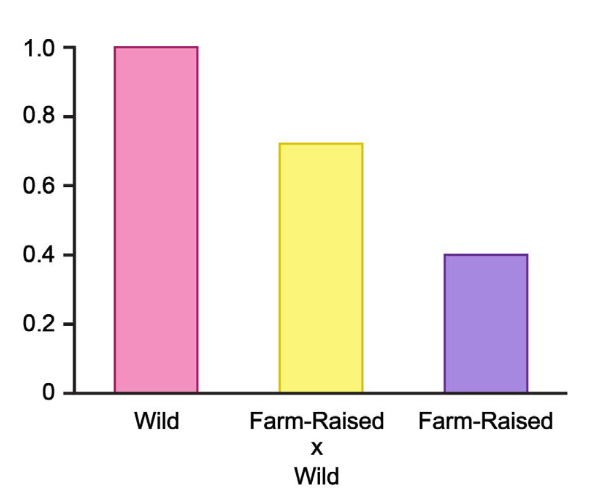Our example is about Isle Royale, and Isle Royale is this kind of famous island in ecology because people have been studying the wolf and moose populations there for a long time. Let's start out just by looking at the map here. Well, we see we're looking at Lake Superior, and here's this Isle Royale. And you can see this is going to be the Canadian coast up here, and there's this ice bridge that we're going to talk about that sometimes connects that island to the mainland. Alright.
So with that information, let's read the problem. It says Isle Royale is a small island off the coast of Michigan's Upper Peninsula in Lake Superior. The island has a small wolf population that ranges between roughly 10 to 50 wolves depending on the year. Just to be clear, that's a really small population size.
Now during cold winters, ice bridges form between the island and the Canadian coast, allowing for wolves and other animals to cross. Due to increased temperatures from global warming, ice bridges have been forming less frequently in recent years. Now with all that information, let's check out the questions. Question A says, based on the wolf population size on Isle Royale, what evolutionary mechanism would you expect to be happening relatively rapidly there?
What do you think? Well, given a really small population size, I would expect genetic drift to be happening rapidly. Genetic drift, we said, happens the most. It's most accentuated in small population sizes, where those random occurrences have much more influence. So genetic drift, small population, expect that to be happening a lot. Question B asks, due to the small population, the wolves on Isle Royale are closely related. How would you expect this to affect the fitness of the population?
I'm going to say it would decrease fitness. It doesn't specifically ask why here, but I'll put in parentheses due to inbreeding depression. When those related individuals keep mating with each other, they're more likely to create homozygotes. That increased homozygosity means that there's more likely that those rare deleterious recessive alleles, they're paired with each other, and that reduces the fitness of organisms.
Question C then asks, what evolutionary mechanism would the formation of ice bridges allow to occur that otherwise would be unlikely? And what do you think about that? Well, we said this ice bridge allows animals to cross between the mainland and the island. That to me sounds like gene flow. And that is one of our evolutionary mechanisms, and you can think genetic drift and inbreeding depression, that's going to be influenced a lot by gene flow. And sure enough, question D asks, how would your answer to C affect the mechanisms that were your answers to A and B? So, the answer to C is gene flow.
How would that affect genetic drift and well that inbreeding depression? I'm just going to say it would counteract them. I'm going to say counteract, and I'll just note, it is because it would introduce new alleles. Genetic drift, you lose alleles in your population. Gene flow will introduce alleles that were potentially lost. As for inbreeding depression, now you have a high number of homozygotes. The more alleles you have in that population, the less inbreeding there is, the less homozygosity you're going to have. So gene flow will counteract both of those.
We got one more question here we're going to scroll down for. It says, imagine that you are a conservation geneticist. Propose a simple solution to maintain the fitness of the wolf population on Isle Royale if ice bridges no longer form between the island and the mainland. So what could you do? What steps could you take to maintain this population? Well, I'm just going to say you could import wolves. If every generation or every few generations, at least, you bring some wolves from the mainland to the island, that's going to sorta renew that gene flow. It's going to introduce those new alleles, and that will slow down the genetic drift or counteract the genetic drift in that inbreeding depression, and it will maintain that wolf population. Now if there's no gene flow going forward, it's really hard to imagine a population size of only 10 to 50 really persisting for a very long time because of those two factors.
With that, we'll practice more going forward, and give it a try.


